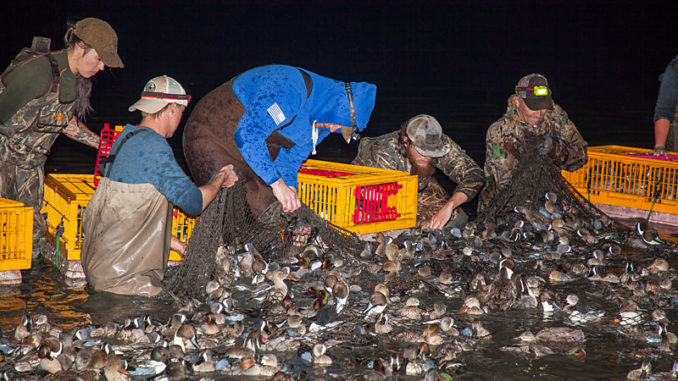
Pintail study designed to show how spring migration impacts reproduction
Paul Link sat quietly in his blind overlooking a strip of shoreline along one of the wetland impoundments on the Louisiana Department of Wildlife and Fisheries Rockefeller Wildlife Refuge.
He’d been baiting the location with a half-ton of rice a night for several weeks.
Meanwhile, over 30 volunteers and waterfowl biologists were assembled a mile and a half away waiting along a levee as the sun was setting.
A text message from Link came to the vehicle where myself and two of the biologists sat with the windows down, in spite of a squadron of marsh mosquitos on the attack. The short, redacted version of his message was essentially we made too much noise deploying and our vehicles and trailers loaded with empty crates spooked the ducks he’d been watching off the bait.
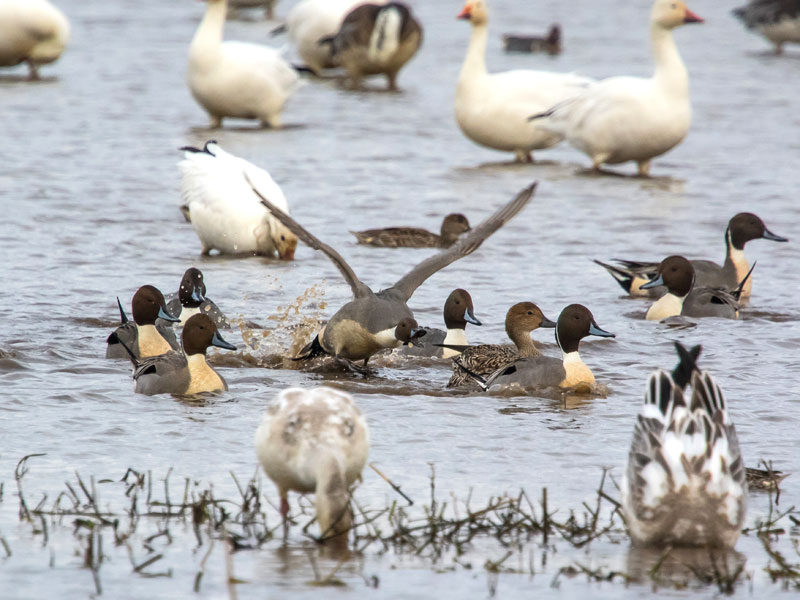
The late afternoon in mid-January was quiet with no wind. The kind of quiet where the sound of voices and activities carry in the distance. Particularly the sound of clanking trailers pulled by pickup trucks on a limestone and gravel levee road. So just like that, the whole event went up in feathers in all directions.
Shoot it!
Link waited to see if the ducks would come back and rush the bait in the twilight. His next message was, “I’m looking at a big black blob, slowly approaching the bait. Don’t know if I should fire the net. What do you think?”
The two biologists I was with both agreed, saying to one of the lead volunteers who was texting Link back and forth, “Just tell him to shoot it.”
The effort it takes to scout a site and bait it for days, inconspicuously set up a rocket net, organize volunteers, plus schedule other biologists to assist with banding is a huge undertaking. Link knew it would be days if not weeks before he could assemble such a platoon for another attempt. And then, it might be too late in the winter.
He fired the net!
A dust cloud rose off the levee road as we sped to the bait site, where upon arrival the crew of volunteers went to work. Much of the big blob Link saw was now captured in the net.
The initial moments seemed both frantic and chaotic, but soon settled into a rhythm. The shot hit its mark. The net was full of ducks. You can’t hide experience when it’s placed in positive motion. And then, soon the net was cleared and void of ducks as the crew worked effectively.
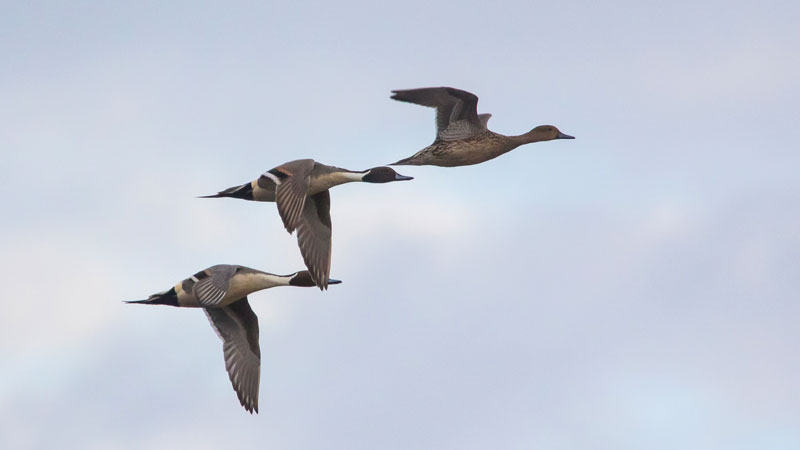
The next phase consisted of segregating the ducks by species and then separating them one step further into crates containing just males and others holding just females for banding purposes. In the crates were blue-winged teal, green-winged teal, northern shovelers, and pintails.
It was the pintails that were of most importance to the massive effort. According to Link, pintails are one of a handful of species that didn’t rebound following the wet cycle on the prairie, where their populations have been on a slow decline for a number of years.
As a result, pintails became the impetus for a Texas A&M University-Kingsville study by Doctoral Candidate Georgina Eccles, titled, “Comparing spring migration strategies of northern pintails originating from different wintering grounds.”
The research is a large, five state three-year collaborative effort, where biologists from participating states place lightweight solar powered GPS/GSM transmitters onto pintails in order to closely track their northerly spring migration. The five states taking part in the study include Arkansas, California, Louisiana, New Mexico and Texas. The goal of the pintail transmitter study is to learn how spring migration impacts reproduction in pintails.
Large player
Because of Link’s skill at catching waterfowl using a rocket net and extensive experience deploying transmitters, Louisiana has become a large player when it comes to participation in the important study. For each of the past three years, he and his team have attached 35 units annually. What’s more, the information biologists hope to gain from the study is crucial.
Link, Rockefeller Wildlife Refuge’s Research Program Manager, said, “They’re very early nesters and we’ve lost a lot of CRP and a lot of native prairie, along with wetland drainage. The Federal wetlands, the first ones that thaw in the spring, are the easiest to drain.”
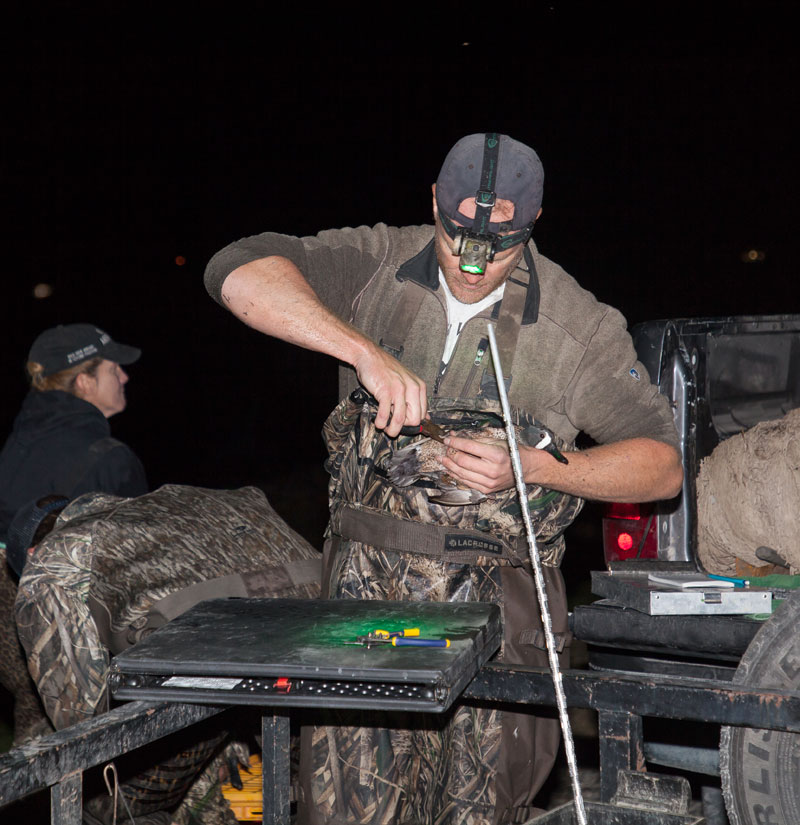
“So, pintails are fighting the ice line getting up north really early and not finding the quality wetlands they once did,” Link continued. “And of course, grasslands are becoming increasingly sparse. A lot of pintails are nesting in croplands just because there’s not a lot of grass left or a lot of native prairie.”
A major result biologists are seeing from the poor habitat conditions is low reproductive effort by pintails. A lot of them, Link said, aren’t even attempting to nest. Moreover, pintails don’t have a lot of re-nesting propensity like mallards do. He refers to it as a “one and done” type thing. Essentially, when pintails get to the prairies and the wetland conditions aren’t perfect, a lot of them forego reproduction and migrate further north. That’s a major reason numbers are down.
By conducting the study on such a large geographic scale, what researchers hope to learn is if certain groups of pintails are doing better than others. Link points out that Arkansas’s habitat is doing a lot better than Louisiana and Texas habitats. Therefore, one of the questions is, are certain wintering areas sending birds north in poor condition versus others that might be doing better?
From her TAMU-Kingsville Doctoral Candidate bio, Eccles’s research focuses on comparing spring migration strategies in northern pintails that originate from different wintering regions across North America to identify key stopover sites during migration and therefore connect decision making to reproductive success.
Link hopes the answers will help biologists target conservation activities and enable them to figure out what’s broken and what they can do to fix it. The long-term populations of pintails has a lot to gain if this study’s results can help.
Over the years, most of the transmitters Link has deployed on waterfowl have utilized a traditional neck and body loop strap harness, which have pros and cons. Ducks go through periods of rapid weight loss, particularly during incubation and molt, and a subsequent period of fattening up. These physiological changes require straps to have a reasonable amount of flexibility.
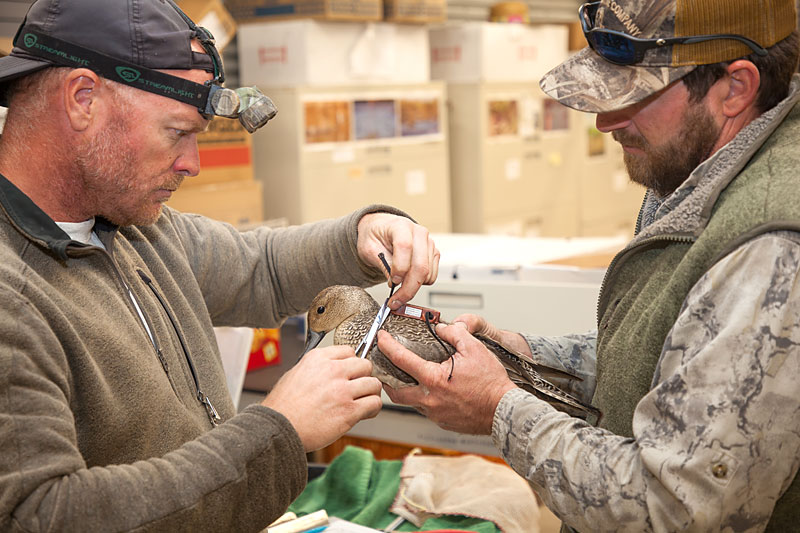
Though harness straps have come a long way over the years, four years ago Link worked directly with an automotive elastic company specifically for the pintail project. Since then, other biologists have picked up on the harness.
“It’s really narrow,” Link said. “It’s elastic and therefore affords some flexibility throughout the annual cycle the birds go through. We’re getting a lot of hunter recoveries and they’re not having the issues we typically get with a solid piece of material that has no stretch, so we’re seeing these are doing a lot better.”
Link has also been working with LDWF State Wildlife Veterinarian Jim LaCour on developing semi-surgical methods of attaching transmitters to waterfowl. The semi-surgical process shows great promise especially as micro-technology advancements continue to improve.
Eccles’s pintail study completed its final year this past spring. Hopefully the results will give waterfowl experts the insight to help give a boost to future pintail populations.


